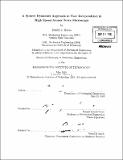| dc.contributor.advisor | Kamal Youcef-Toumi. | en_US |
| dc.contributor.author | Burns, Daniel James | en_US |
| dc.contributor.other | Massachusetts Institute of Technology. Dept. of Mechanical Engineering. | en_US |
| dc.date.accessioned | 2011-03-07T15:20:28Z | |
| dc.date.available | 2011-03-07T15:20:28Z | |
| dc.date.copyright | 2010 | en_US |
| dc.date.issued | 2010 | en_US |
| dc.identifier.uri | http://hdl.handle.net/1721.1/61594 | |
| dc.description | Thesis (Ph. D.)--Massachusetts Institute of Technology, Dept. of Mechanical Engineering, 2010. | en_US |
| dc.description | Cataloged from PDF version of thesis. | en_US |
| dc.description | Includes bibliographical references (p. 135-146). | en_US |
| dc.description.abstract | As progress in molecular biology and nanotechnology continues, demand for rapid and high quality image acquisition has increased to the point where the limitations of atomic force microscopes (AFM) become impediments to further discovery. Many biological processes of interest occur on time scales faster than the observation capability of conventional AFMs, which are typically limited to imaging rates on the order of minutes. Imaging at faster scan rates excite resonances in the mechanical scanner that can distort the image, thereby preventing higher speed imaging. Although traditional robust feedforward controllers and input shaping have proven effective at minimizing the influence of scanner distortions, the lack of direct measurement and use of model-based controllers has required disassembling the microscope to access lateral motion with external sensors in order to perform a full system identification experiment, which places excessive demands on routine microscope operators. This work represents a new way to characterize the lateral scanner dynamics without addition of lateral sensors, and shape the commanded input signals in such a way that disturbing dynamics are not excited in an automatic and user-independent manner. Scanner coupling between the lateral and out-of-plane directions is exploited and used to build a minimal model of the scanner that is also sufficient to describe the source of the disturbances. This model informs the design of an online input shaper used to suppress components of the high speed command signals. The method presented is distinct from alternate approaches in that neither an information-complete system identification experiment, nor microscope modification are required. This approach has enabled an increase in the scan rates of unmodified commercial AFMs from 1-4 lines/second to over 100 lines/second and has been successfully applied to a custom-built high speed AFM, unlocking scan rates of over 1,600 lines/second. Images from this high speed AFM have been taken at more than 10 frames/second. Additionally, bulky optical components for sensing cantilever deflection and low bandwidth actuators constrain the AFM's potential observations, and the increasing instrument complexity requires operators skilled in optical alignment and controller tuning. Recent progress in MEMS fabrication has allowed the development of a new type of AFM cantilever with an integrated sensor and actuator. Such a fully instrumented cantilever enables direct measurement and actuation of the cantilever motion and interaction with the sample, eliminating the need for microscope operators to align the bulky optical components. This technology is expected to not only allow for high speed imaging but also the miniaturization of AFMs and expand their use to new experimental environments. Based on the complexity of these integrated MEMS devices, a thorough understanding of their behavior and a specialized controls approach is needed to guide non-expert users in their operation and extract high performance. The intrinsic properties of such MEMS cantilevers are investigated, and a combined approach is developed for sensing and control, optimized for high speed detection and actuation. | en_US |
| dc.description.statementofresponsibility | by Daniel J. Burns. | en_US |
| dc.format.extent | 146 p. | en_US |
| dc.language.iso | eng | en_US |
| dc.publisher | Massachusetts Institute of Technology | en_US |
| dc.rights | M.I.T. theses are protected by
copyright. They may be viewed from this source for any purpose, but
reproduction or distribution in any format is prohibited without written
permission. See provided URL for inquiries about permission. | en_US |
| dc.rights.uri | http://dspace.mit.edu/handle/1721.1/7582 | en_US |
| dc.subject | Mechanical Engineering. | en_US |
| dc.title | A system dynamics approach to user independence in high speed atomic force microscopy | en_US |
| dc.title.alternative | System dynamics approach to user independence in high speed AFM | en_US |
| dc.type | Thesis | en_US |
| dc.description.degree | Ph.D. | en_US |
| dc.contributor.department | Massachusetts Institute of Technology. Department of Mechanical Engineering | |
| dc.identifier.oclc | 704294076 | en_US |

